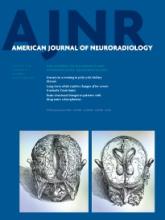Research ArticleBrain
Open Access
Morphologic, Distributional, Volumetric, and Intensity Characterization of Periventricular Hyperintensities
M.C. Valdés Hernández, R.J. Piper, M.E. Bastin, N.A. Royle, S. Muñoz Maniega, B.S. Aribisala, C. Murray, I.J. Deary and J.M. Wardlaw
American Journal of Neuroradiology January 2014, 35 (1) 55-62; DOI: https://doi.org/10.3174/ajnr.A3612
M.C. Valdés Hernández
aFrom the Brain Research Imaging Centre (M.C.V.H., M.E.B., N.A.R., S.M.M., B.S.A., J.M.W.)
R.J. Piper
bCollege of Medicine and Veterinary Medicine (R.J.P.)
M.E. Bastin
aFrom the Brain Research Imaging Centre (M.C.V.H., M.E.B., N.A.R., S.M.M., B.S.A., J.M.W.)
cDivision of Health Sciences (Medical Physics) (M.E.B.)
N.A. Royle
aFrom the Brain Research Imaging Centre (M.C.V.H., M.E.B., N.A.R., S.M.M., B.S.A., J.M.W.)
S. Muñoz Maniega
aFrom the Brain Research Imaging Centre (M.C.V.H., M.E.B., N.A.R., S.M.M., B.S.A., J.M.W.)
B.S. Aribisala
aFrom the Brain Research Imaging Centre (M.C.V.H., M.E.B., N.A.R., S.M.M., B.S.A., J.M.W.)
C. Murray
dDepartment of Psychology (C.M., I.J.D.), University of Edinburgh, Edinburgh, UK.
I.J. Deary
dDepartment of Psychology (C.M., I.J.D.), University of Edinburgh, Edinburgh, UK.
J.M. Wardlaw
aFrom the Brain Research Imaging Centre (M.C.V.H., M.E.B., N.A.R., S.M.M., B.S.A., J.M.W.)

REFERENCES
- 1.↵
- Wen W,
- Sachdev P
- 2.↵
- Fazekas F,
- Chawluk JB,
- Alavi A,
- et al
- 3.↵
- Krishnan KR,
- Boyko OB,
- McDonald WM,
- et al
- 4.↵
- Brickman AM,
- Sneed JR,
- Provenzano FA,
- et al
- 5.↵
- Payne ME,
- Fetzer DL,
- MacFall JR,
- et al
- 6.↵
- 7.↵
- 8.↵
- Sachdev P,
- Chen X,
- Wen W
- 9.↵
- van der Lijn F,
- Verhaaren BF,
- Ikram MA,
- et al
- 10.↵
- Ge Y,
- Grossman RI,
- Babb JS,
- et al
- 11.↵
- 12.↵
- DeCarli C,
- Fletcher E,
- Ramey V,
- et al
- 13.↵
- 14.↵
- Wardlaw JM,
- Bastin ME,
- Valdés Hernández MC,
- et al
- 15.↵
- van Straaten EC,
- Fazekas F,
- Rostrup E,
- et al
- 16.↵
- 17.↵
- Conijn MM,
- Kloppenborg RP,
- Algra A,
- et al
- 18.↵
- Moore GR,
- Laule C,
- Mackay A,
- et al
- 19.↵
- Filippi M,
- Rocca MA
- 20.↵
- Valdés Hernández MC,
- Morris Z,
- Dickie DA,
- et al
- 21.↵
- 22.↵
- Bakshi R,
- Caruthers SD,
- Janardhan V,
- et al
- 23.↵
- Mayer PL,
- Kier EL
- 24.↵
- 25.↵
- Murray AD,
- Staff RT,
- Shenkin SD,
- et al
- 26.↵
- Godin O,
- Tzourio C,
- Maillard P,
- et al
- 27.↵
- de Leeuw FE,
- de Groot JC,
- Oudkerk M,
- et al
- 28.↵
- Pantoni L,
- Garcia JH
- 29.↵
- De Groot CJ,
- Bergers E,
- Kamphorst W,
- et al
- 30.↵
- Admiraal-Behloul F,
- van den Heuvel DM,
- Olofsen H,
- et al
- 31.↵
- Klöppel S,
- Abdulkadir A,
- Hadjidemetriou S,
- et al
- 32.↵
- 33.↵
- Scully M,
- Anderson B,
- Lane T,
- et al
In this issue
American Journal of Neuroradiology
Vol. 35, Issue 1
1 Jan 2014
Advertisement
M.C. Valdés Hernández, R.J. Piper, M.E. Bastin, N.A. Royle, S. Muñoz Maniega, B.S. Aribisala, C. Murray, I.J. Deary, J.M. Wardlaw
Morphologic, Distributional, Volumetric, and Intensity Characterization of Periventricular Hyperintensities
American Journal of Neuroradiology Jan 2014, 35 (1) 55-62; DOI: 10.3174/ajnr.A3612
0 Responses
Morphologic, Distributional, Volumetric, and Intensity Characterization of Periventricular Hyperintensities
M.C. Valdés Hernández, R.J. Piper, M.E. Bastin, N.A. Royle, S. Muñoz Maniega, B.S. Aribisala, C. Murray, I.J. Deary, J.M. Wardlaw
American Journal of Neuroradiology Jan 2014, 35 (1) 55-62; DOI: 10.3174/ajnr.A3612
Jump to section
Related Articles
- No related articles found.
Cited By...
This article has not yet been cited by articles in journals that are participating in Crossref Cited-by Linking.
More in this TOC Section
Similar Articles
Advertisement











